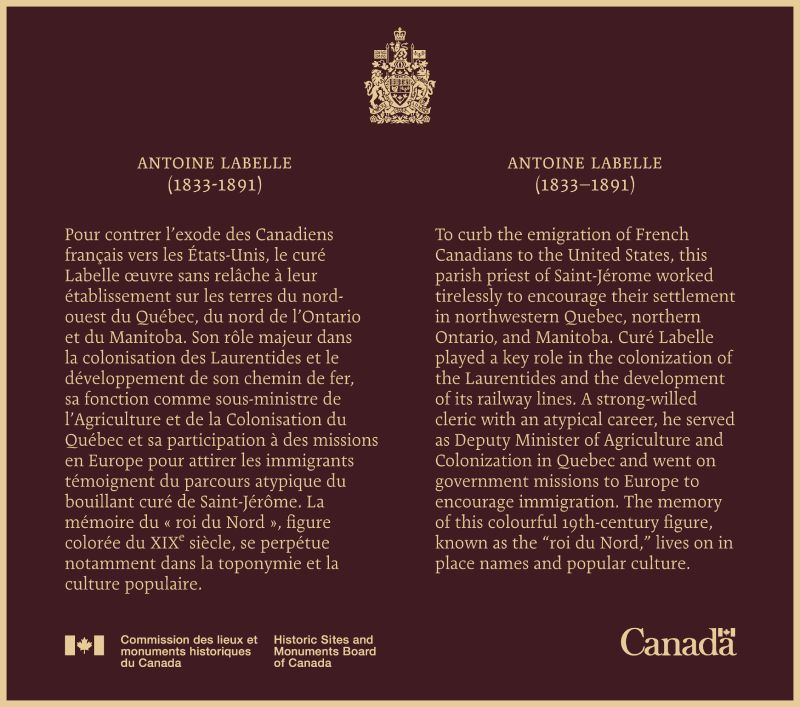Curé Antoine Labelle National Historic Person (1833-1891)
Curé Antoine Labelle was designated a national historic person in 2019.
Historical importance: Legendary figure in Quebec, he encouraged French Canadians to settle in areas of northern Quebec and Ontario, and Manitoba.
Commemorative plaque: Cathédrale of Saint-Jérôme, 355, place du Curé-Labelle, Saint-Jérôme, Quebec Footnote 1
To curb the emigration of French Canadians to the United States, this parish priest of Saint-Jérome worked tirelessly to encourage their settlement in northwestern Quebec, northern Ontario, and Manitoba. Curé Labelle played a key role in the colonization of the Laurentides and the development of its railway lines. A strong-willed cleric with an atypical career, he served as Deputy Minister of Agriculture and Colonization in Quebec and went on government missions to Europe to encourage immigration. The memory of this colourful 19th-century figure, known as the “roi du Nord,” lives on in place names and popular culture.
Curé Antoine Labelle (1833-1891)
A prominent figure in Quebec in the late 19th century, Antoine Labelle was a Catholic priest who was the pastor of Saint-Jérôme parish from 1868 to 1891. Nicknamed the “King of the North,” he came up with a plan to resettle French Canadians in northwestern Quebec, northern Ontario and Manitoba, in order to curb their exodus to the United States. A key figure in the colonization of the Laurentians and a promoter of its economic development and rail network, Labelle helped found some 20 parishes and settle close to 5,000 inhabitants in the region. He went on two government missions to Europe, in 1885 and 1889, to recruit new French speaking settlers and stimulate economic trade. Labelle is also recognized for his role as deputy minister of Quebec’s Department of Agriculture and Colonization from 1888 to 1890. Known as “Curé Labelle,” his memory lives on in place names and popular television series.
Born in 1833 in Sainte-Rose (Laval), Lower Canada, Antoine Labelle left home at age 10 to attend the Petit Séminaire de Sainte-Thérèse, where he studied until 1852 and, subsequently, did his theological training. From 1855 to 1856, he completed his studies at the Grand Séminaire de Montréal and was ordained a priest at the age of 23. In the 12 years that followed, he worked in a number of parishes and was given his first posting as parish priest in Saint-Antoine-Abbé, in the county of Huntingdon, in 1859. It was while ministering in that parish that he developed his skills as a mediator and learned of the severity of the massive emigration of French Canadians to New England. On May 15, 1868, Labelle was appointed pastor of Saint-Jérôme parish, a community that he served for 22 years. With his major influence in the Conservative Party, he embarked on an ambitious plan to promote the possibility of developing new agricultural land northwest of the Island of Montréal to stem the tide of French-Canadian emigration to the United States.
Curé Labelle’s colonization plan was consistent with the colonial logic that existed in Quebec in the 19th century. At that time, the population of European origin in Lower Canada was growing and encroaching upon Indigenous territories in the St. Lawrence River Valley, while the territories situated inland were the targets of forestry development and colonization. The region that Labelle set his sights on had been occupied by various populations for nearly 6,000 years and is part of the Algonquin-Anishinabe territory. Confronted with colonial expansion, the Algonquin-Anishinabeg petitioned colonial authorities for the protection of their territories and financial compensation for the lands occupied without their consent. In response, the government reserved some land for their exclusive use, which also served the government’s objective of assimilation and colonization, designed to force First Nations to settle permanently and adopt an agriculture-based lifestyle. However, the Anishinabeg did not give up their traditional territory; they continued to live there and engage in many subsistence activities.
Curé Labelle became a Quebec legend through his work, but also through those who have perpetuated his memory, including Claude-Henri Grignon, who portrayed him in the television series Les belles histoires des pays d’en haut, and through the many place names in Quebec dedicated to his memory.
Backgrounder last update: 2022-05-04
The National Program of Historical Commemoration relies on the participation of Canadians in the identification of places, events and persons of national historic significance. Any member of the public can nominate a topic for consideration by the Historic Sites and Monuments Board of Canada.
- Date modified :

